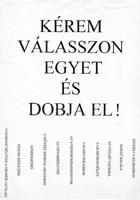Before
I came to Budapest, it was quite common that whenever I engaged
with people from other walks of life than art in Edinburgh or Glasgow,
on learning that I was at art school, people felt compelled to offer
me their opinions on the last 'modern art' exhibition they'd seen
or heard about. Usually this involved descriptions of how the artist
had made something that, for example, consisted of a "load
of junk", or was just a text on a wall, or some out of focus
photographs, something that "anyone could make," lacking
the sufficient craft and skill to prove their status as an 'artist'.
The use of contemporary, everyday materials and techniques often
in quite modest arrangements - factors that I regarded positively
at least in terms of democratising the language of art and therefore
as containing the potential for a broader public to identify with
the work - were exactly what seemed to be the problem. The public
outrage (incited by the media) over the substantial amount of public
money spent by the Tate gallery in purchasing Carl Andre's "Equivalent
VIII" (or "pile of bricks" as it became known) in
1972 is a classic example in the UK of public attitudes towards
'modern art'. Far from being convinced by concepts behind the visual
presentation of the work, the artist was regarded by a large part
of the public as a lazy trickster - the emperor without any clothes
– who didn't fool them. In that particular debate and amongst
those who felt strongly enough to elaborate on it, the critics'
cited classic works of art in traditional mediums as examples of
what proper art should be. For me and some others at the art school,
these discrepancies in understanding and accepting what can constitute
art were disturbing and somewhat depressing, but still in hoping
to make work that could go beyond the confines of an already art-interested
audience, confronting these problems was necessary.
A
one-liner is a very easy and quick to tell joke - consisting of
one line. I noticed the expression 'throwaway one-liners' being
used as a pejorative description in some reviews of quite simple
art works which often employed some humour (and which I quite appreciated).
Making
a very simple and lightly humorous work as a parody of what a one-liner
is, whilst also wanting to take a take a jibe at proponents of conservative
art techniques and values, I made a series of small objects that
were based on literal or pun-like depictions of derogatory comments
that could be made about the kind of contemporary art that doesn't
display sufficient 'talent or 'craft' to inspire awe in the observer
and reassure (certain) observers by keeping intact their preconceived
and desired perceptions of artists as purveyors of a unique genius
whose life and work is quite separate from the realm of any 'normal'
person.
Judging
from the emphasis on mastering technical skills and attaining a
high level of accuracy in fields such as anatomical representation
as seen in the painting and sculpture departments, and the general
stuffy atmosphere (at this time) of the academy of art in Budapest
(with the exception, at least, of the intermedia department), it
wasn't too inspiring for me on arriving to find much of these kind
of prejudices already contained within the structure of the art
school.
The
photocopied A4 flyers with the command: "Please take one and
throw it away" make textual 'one-liners' of the titles of some
of the public's most acknowledged works of art. listed are the titles
of works by David, Michelangelo, Manet, Monet, Picasso, Rodin, Seraut,
Van Gogh, and Velasquez. The command makes literal the term 'throwaway,'
and in what seems to be a futile request - to take a name away,
only to put in a bin - encourages the passerby to undergo a symbolic
gesture like some psychological self improvement strategy. These
were attached or pasted to notice boards on which there were already
a preponderance of flyers with tear off strips, in and around the
art school in Budapest.
Intermedia, House of Culture, Paks, July, 1996.

